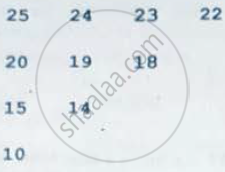Advertisements
Advertisements
Question
ARR[15] ft:20] is a two-dimensional array, which is stored in the memory along the row with each of its elements occupying 4 .bytes. Find the .address of the element ARR[5)[15], if the element ARR[lO] [5] is stored at the memory location 35000.
Solution
Given:
Arr[15][20]
W = 4 B = ? Lr = 0 Lc = 0 R = 15 C = 20
Address of Arr[5][15] = ?
Address of [10][5] = 35000
Address of an element (I,J) in row major = B + W(C(I - Lr) + (J - Lc))
Therefore 35000 = B + 4(20(10 - 0) + (5 - 0))
= B + 4(20 x 10 + 5)
= B + 4(200 + 5)
= B + 4 x 205
= B + 820
B = 34180
Address of Arr[5][15] = 34180 + 4(20 x 5 + 15)
= 34180 + 4(100 + 15)
= 34180 + 4 x 115
= 34180 + 460
= 34640
APPEARS IN
RELATED QUESTIONS
Write the definition of a function SumEO(int VALUES[], int N) in C++, which should display the 4 sum of even value and sum of odd values of the array separately.
Example: If the array VALUES contains
| 25 | 20 | 22 | 21 | 53 |
Then the functions should display the output as:
Sum of even values = 42 (i.e., 20+22)
Sum of odd values= 99 (i.e., 25+21+53)
Write a definition for a function UpperHalf(int Mat[4][4]) in C++ which displays the elements in the same way as per the example is shown below.
For example, if the content of the array Mat is as follows:
| 25 | 24 | 23 | 22 |
| 20 | 19 | 18 | 17 |
| 15 | 14 | 13 | 12 |
| 10 | 9 | 8 | 7 |
Thew function should display the content in the following format:

Let us assume Data[20][15] is a two-dimensional array, which is stored in the memory along the row with each of its elements occupying 2 bytes. Find the address of the element Data(10][5], if the element Data[10][l5] is stored at the memory location 15000.
A two-dimensional array ARR[50][20] is stored in the memory along the row with each of its elements occupying 4 bytes. Find the address of the element ARR[30] [10], if the element ARR[10] [5] is stored at the memory location 15000.
Write a function REVROW(int P[] [5], int N, int M) in C++ to display the content of a two-dimensional array, with each row content in reverse order.
For example, if the content of the array is as follows:
| 15 | 12 | 56 | 45 | 51 |
| 13 | 91 | 92 | 87 | 63 |
| 11 | 23 | 61 | 46 | 81 |
The function should display output as

